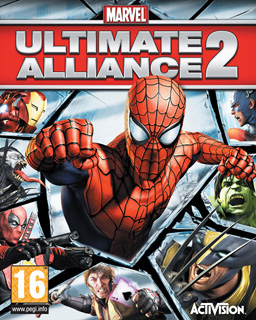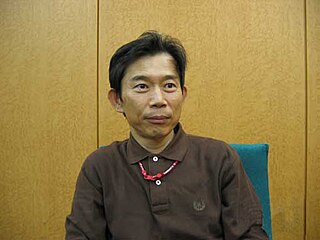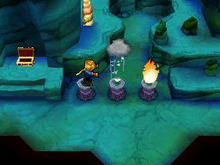
Waluigi is a character in the Mario franchise. He plays the role of Luigi's arch-rival and accompanies Wario in spin-offs from the main Mario series, often for the sake of causing mischief. He was created by Camelot employee Fumihide Aoki and was voiced from 2000 to 2022 by Charles Martinet, who described Waluigi as someone with a lot of self-pity. Waluigi's design is characterised by his tall stature, thin and lanky frame, and his purple and black outfit with purple hat, which displays an inverted yellow "L".

Golden Sun is a role-playing video game developed by Camelot Software Planning and published by Nintendo for the Game Boy Advance. It was released in August 2001 in Japan, November 2001 in North America and February 2002 in Europe.

Golden Sun: The Lost Age, released under different names in some regions, is a 2002 role-playing video game for the Game Boy Advance, developed by Camelot Software Planning and published by Nintendo. It is the second installment in the Golden Sun series and was released on June 28, 2002 in Japan, and in 2003 in North America and Europe.

Super Mario 64 DS is a 2004 platform game developed and published by Nintendo for the Nintendo DS. It was a launch game for the DS. Super Mario 64 DS is a remake of the 1996 Nintendo 64 game Super Mario 64, with new graphics, characters, collectibles, a multiplayer mode, and several extra minigames. As with the original, the plot centers on rescuing Princess Peach from Bowser. Unlike the original, Yoshi is the first playable character, with Mario, Luigi, and Wario being unlockable characters in early phases of the game.

Mario Power Tennis is a sports game developed by Camelot Software Planning and published by Nintendo. The game is the sequel to the Nintendo 64 title Mario Tennis, and is the fourth game in the Mario Tennis series. Power Tennis was released for the GameCube in Japan and North America in late 2004, and in PAL regions in early 2005. The game was ported for the Wii in 2009 as part of the New Play Control! series, and was also re-released as a Nintendo Selects title in 2012. A companion handheld game, Mario Tennis: Power Tour, was also released on Game Boy Advance around the same time as the original GameCube release, bearing the same title as Power Tennis in Europe.

Nintendogs is a real-time pet simulation video game developed and published by Nintendo for the Nintendo DS handheld video game console. It was released in Japan, and was later released in: North America, Australia, New Zealand, Europe and other regions. It was originally released in three different versions: Dachshund & Friends, Lab & Friends and Chihuahua & Friends. It has been re-released twice, first as a bundled release with a special edition Nintendo DS with a new version called Nintendogs: Best Friends and later as Nintendogs: Dalmatian & Friends.

Camelot Co., Ltd. is a Japanese video game developer established in 1994 and headquartered in Shinjuku, Tokyo. It is known for developing sports games, particularly in Nintendo's Mario franchise.

Castlevania: Dawn of Sorrow is a 2005 action role-playing game developed and published by Konami. It is part of Konami's Castlevania video game series and the first Castlevania game released on the Nintendo DS. The game is the sequel to Castlevania: Aria of Sorrow and incorporates many elements from its predecessor. Dawn of Sorrow was commercially successful. It sold more than 15,000 units in its first week in Japan and 164,000 units in the United States during the three months after its initial release.
Tetsuya Takahashi is a Japanese video game designer, writer and director. Takahashi worked at Square in the 90s as a graphic designer and graphic director, participating on some of their most well-received titles such as Final Fantasy V, Final Fantasy VI and Chrono Trigger, before directing and co-writing Xenogears. He left Square in 1999 to co-found Monolith Soft, where he would develop the Xenosaga and Xenoblade Chronicles series with Namco and Nintendo respectively, being the executive director of Xenoblade since the first entry in the series.

Mario Golf: Advance Tour is a role-playing video game-styled sports game developed by Camelot Software Planning and published by Nintendo for the Game Boy Advance in 2004. The game is the sequel to the Game Boy Color version of Mario Golf and the Game Boy Advance counterpart of Mario Golf: Toadstool Tour.

Advance Wars: Days of Ruin, released as Advance Wars: Dark Conflict in Europe and Australia, is a turn-based strategy video game for the Nintendo DS handheld game console. It is the fourth installment in the Advance Wars series after Advance Wars: Dual Strike and was released in 2008 for North America on January 21; in Europe on January 25; and in Australia on February 21. A Japanese release was planned under the title of Famicom Wars DS: Lost Light, but was canceled after a series of delays. It finally became available in Japan through Club Nintendo in October 2013 as a downloadable platinum status reward for the Nintendo 3DS family of systems.

Kingdom Hearts 358/2 Days is an action role-playing video game developed by h.a.n.d. and Square Enix in collaboration with Disney Interactive Studios for the Nintendo DS. It is the fifth installment in the Kingdom Hearts series, and takes place near the end of the first game in parallel to Kingdom Hearts: Chain of Memories, leading directly into the events of Kingdom Hearts II. The game was released worldwide in 2009. The story is told from the perspective of Roxas, and follows his daily life within Organization XIII and his relationship with fellow Organization member Axel; it also introduces a fourteenth member, Xion, who befriends them.

Soma Bringer is a 2008 action role-playing game developed by Monolith Soft and published by Nintendo for the Nintendo DS. The player, controlling one of the eight main characters, explores dungeons and fights enemies in real-time combat across three-dimensional plains from a top-down perspective. Multiplayer functions allow up to three players to participate in exploration and combat. The story takes place on the continent of Barnea, where its principle magical energy, Soma, is disrupted by the arrival of monsters called Visitors. This prompts a military group called Pharzuph Division 7 to defeat the Visitors and restore the balance of Soma.

Marvel: Ultimate Alliance 2 is a 2009 action role-playing video game featuring characters from Marvel Comics. It is the sequel to 2006's Marvel: Ultimate Alliance, and the second installment in the Marvel: Ultimate Alliance series. The game was jointly developed by Vicarious Visions, n-Space and Savage Entertainment and published by Activision in September 2009. A port for the PlayStation 4, Xbox One and Microsoft Windows by Zoë Mode was released in July 2016.

Scribblenauts is an emergent puzzle action video game developed by 5th Cell and published by Warner Bros. Interactive Entertainment for the Nintendo DS. The game was released in 2009 in all regions except Japan, and in 2011 in Japan as Flash Puzzle: Maxwell's Mysterious Notebook by Konami. It is the third Nintendo DS video game made by 5th Cell, the first two being Drawn to Life and Lock's Quest. The objective of Scribblenauts, as implied by its catchphrase "Write Anything, Solve Everything", is to complete puzzles to collect "Starites", helped by the player's ability to summon any object by writing its name on the touchscreen. The game is considered by its developers to help promote emergent gameplay by challenging the player to solve its puzzles within certain limitations or through multiple solutions.

Mario & Sonic at the Olympic Winter Games is a 2009 sports and party game developed by Sega. Like its predecessor, it was published by Nintendo for Japan and Korea and by Sega in the Western world. The game is officially licensed by the International Olympic Committee (IOC) through exclusive license International Sports Multimedia. The game is the third official crossover title to feature characters from both Mario and Sonic's respective universes, the first and second being the game's predecessor Mario & Sonic at the Olympic Games and Super Smash Bros. Brawl respectively. It was released on the Wii and the Nintendo DS in October 2009, and is the first official video game of the 2010 Winter Olympic Games.

The Legend of Zelda: Spirit Tracks is a 2009 action-adventure game developed and published by Nintendo for the Nintendo DS handheld game console. Set a century after The Wind Waker and its sequel Phantom Hourglass, the storyline follows the current incarnations of Link and Princess Zelda as they explore the land of New Hyrule to prevent the awakening of the Demon King Malladus. Players navigate New Hyrule, completing quests that advance the story and solving environmental and dungeon-based puzzles, many requiring use of the DS's touchscreen and other hardware features. Navigation between towns and dungeons is done using a train, which features its own set of mechanics and puzzles.
Golden Sun is a series of fantasy role-playing video games developed by Camelot Software Planning and published by Nintendo. It follows the story of a group of magically-attuned "adepts" who are charged with preventing the potentially destructive power of alchemy from being released as it was in the past. Players navigate characters through the game's world by defeating enemies, solving puzzles, and completing assigned missions to complete the storyline.

Hiroyuki Takahashi, is the president of the video game development studio Camelot Software Planning. He has participated in most of the company's projects as a game designer, producer, and writer.

Ni no Kuni: Dominion of the Dark Djinn is a role-playing video game developed and published by Level-5. It was released in Japan for the Nintendo DS on December 9, 2010. Players control Oliver, a young boy who sets out on a journey to save his mother. The game is played from a third-person perspective and its world is navigated on foot or by boat. While players navigate Oliver throughout the game's world, other characters can be controlled during battles against enemies; during these battles, players use magic abilities and creatures known as "imajinn", which can be captured and tamed.





















